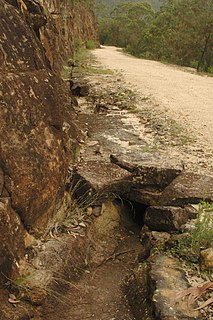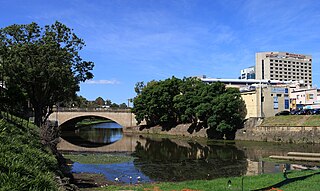 W
WThe Castle Hill rebellion of 1804 was a rebellion by convicts against the colonial authority of the British colony of New South Wales in the Castle Hill area, in Sydney. The rebellion culminated in a battle fought between convicts and the colonial forces of Australia on 5 March 1804 at Rouse Hill, dubbed the Second Battle of Vinegar Hill after the first Battle of Vinegar Hill which had taken place in 1798 in Ireland. It was the first major convict uprising in Australian history suppressed under martial law.
 W
WCockatoo Island is a UNESCO World Heritage Site at the junction of the Parramatta and Lane Cove River in Sydney Harbour, New South Wales, Australia.
 W
WThe Cox's Road and Early Deviations - Hartley, Clarence Hilly Range and Mount Blaxland Precinct is a heritage-listed road at The Old Bathurst Road, Hartley in the City of Lithgow local government area of New South Wales, Australia. It was designed and built by William Cox from 1814 to 1826 with the support of a convict road party. It is also known as Cox's Road and Early Deviations - Hartley, Clarence Hilly Range / Mount Blaxland Precinct and Coxs Road. It was added to the New South Wales State Heritage Register on 25 March 2015.
 W
WCox's Road and Early Deviations - Linden, Linden Precinct is a heritage-listed former road and now fire trail and road at off Railway Parade, Linden, City of Blue Mountains, New South Wales, Australia. It was designed and built by William Cox from 1814, with the assistance of a convict road party.. It is also known as Old Bathurst Road and Coxs Road. It was added to the New South Wales State Heritage Register on 31 July 2015.
 W
WCox's Road and Early Deviations - Mount York, Cox's Pass Precinct is a heritage-listed former colonial road and now walking track at Mount York Road (off), Mount Victoria, City of Blue Mountains, New South Wales, Australia. It was designed and built by William Cox from 1814, with the assistance of the convict road party. It is also known as Old Bathurst Road; Bathurst Road; Historic Crossings Walking Track and Coxs Road. It was added to the New South Wales State Heritage Register on 25 March 2015.
 W
WCox's Road and Early Deviations - Sodwalls, Fish River Descent Precinct is a heritage-listed former colonial road and now road and access road at off Cuthill Road, Sodwalls in the City of Lithgow local government area of New South Wales, Australia. It was designed and built by William Cox from 1814 to 1815 with the support of a convict road party. It is also known as Coxs Road and Old Bathurst Road. It was added to the New South Wales State Heritage Register on 25 March 2015.
 W
WThe Cox's Road and Early Deviations - Woodford, Appian Way Precinct is a heritage-listed former colonial road and now access road off The Appian Way, near Woodford, in the City of Blue Mountains local government area of New South Wales, Australia. It was designed and built by William Cox between 1814 and 1825, with the assistance of a convict road party. It is also known as Bathurst Road; Old Bathurst Road and Coxs Road. It was added to the New South Wales State Heritage Register on 25 March 2015.
 W
WCox's Road and Early Deviations - Woodford, Old Bathurst Road Precinct is a heritage-listed former colonial road and now fire trail and road located at Old Bathurst Road, Woodford in the City of Blue Mountains local government area of New South Wales, Australia. It was designed and built by William Cox from 1814, with the support of a convict road party. It is also known as 1814 Road, Old Bathurst Road, Old Western Road and Coxs Road. It was added to the New South Wales State Heritage Register on 31 July 2015.
 W
WThe Great North Road is a historic road that was built to link early Sydney, in the Colony of New South Wales, now Australia, with the fertile Hunter Valley to the north. Built by convicts between 1825 and 1836, it traverses over 260 kilometres (162 mi) of the rugged terrain that hindered early agricultural expansion.
 W
WThe Hive Shipwreck is a heritage-listed shipwreck site of the Hive, a former convict transportation ship located approximately 40 metres (130 ft) off Bherwerre Beach, Jervis Bay Territory, Australia. It was added to the New South Wales State Heritage Register on 1 April 2010.
 W
WThe Hyde Park Barracks, Sydney is a heritage-listed former barracks, hospital, convict accommodation, mint and courthouse and now museum and cafe located at Macquarie Street in the Sydney central business district, in the City of Sydney local government area of New South Wales, Australia. Originally built from 1811 to 1819 as a brick building and compound to house convict men and boys, it was designed by convict architect Francis Greenway. It is also known as the Mint Building and Hyde Park Barracks Group and Rum Hospital; Royal Mint - Sydney Branch; Sydney Infirmary and Dispensary; Queen's Square Courts; Queen's Square. The site is managed by the Sydney Living Museums, an agency of the Government of New South Wales, as a living history museum open to the public.
 W
WThe Lennox Bridge, Glenbrook is a heritage-listed road bridge that carries the Mitchell's Pass across Brookside Creek, located at Glenbrook, in the City of Blue Mountains local government area of New South Wales, Australia. The bridge was designed by David Lennox and built from 1832 to 1833 by James Randall and other convicts. It is also known as Lennox Bridge or The Horseshoe Bridge. The property is owned by Blue Mountains City Council. It was added to the New South Wales State Heritage Register on 2 April 1999. The stone arch bridge is a single arch of 6 metres (20 ft) span and is 9 metres (30 ft) above water level, with a road width of 9 metres (30 ft).
 W
WThe Lennox Bridge is a heritage-listed sandstone single arch bridge across the Parramatta River, located in Parramatta in Western Sydney, New South Wales, Australia. The bridge was designed by and built under the supervision of David Lennox, the first Colonial Superintendent of Bridges using convict labour between 1836 and 1839. The Lennox Bridge is the third oldest surviving masonry bridge in New South Wales. The bridge carries Church Street, the main north-south street of Parramatta's central business district. It was added to the New South Wales State Heritage Register on 2 April 1999.
 W
WThe New South Wales Marine Corps (1786–1792) was an ad hoc volunteer unit that the British Royal Navy created to guard the convicts aboard the First Fleet to Australia, and to preserve "subordination and regularity" in the penal colony in New South Wales.
 W
WThe Old Government House is a heritage-listed former "country" residence used by ten early governors of New South Wales between 1800 and 1847, located in Parramatta Park in Parramatta, New South Wales, in the greater metropolitan area of Western Sydney, New South Wales, Australia. It is considered a property of national and international significance as an archaeological resource. It also serves to demonstrate how the British Empire expanded and Australian society has evolved since 1788.
 W
WOverseers' Cottages Remains is a heritage-listed archaeological site, now incorporated into the Glasshouse entertainment centre, at 30-44 Clarence Street, Port Macquarie, Port Macquarie-Hastings Council, New South Wales, Australia. It is the remains of cottages for convict overseers', built from 1823 to 1830 by convict labour. The property is owned by Port Macquarie-Hastings Council. It was added to the New South Wales State Heritage Register on 13 August 2010.
 W
WThe Parramatta Female Precinct, in the former penal colony of New South Wales, is located in the grounds of Cumberland Hospital, North Parramatta, New South Wales, Australia. It was one of 13 female factories in the colonies of New South Wales and Van Diemen's Land. In New South Wales, female factories were also established in Bathurst, Newcastle, Port Macquarie and Moreton Bay. The factory idea was a combination of the functions of the British bridewells, prisons and workhouses.
 W
WThe Parramatta Female Factory and Institutions Precinct is a heritage-listed conservation site in Parramatta, in the City of Parramatta local government area of New South Wales, Australia. The site was used as the historically significant Parramatta Female Factory from 1821 to 1848. After its closure, the main factory buildings became the basis for the Parramatta Lunatic Asylum, while another section of the site was used for a series of other significant institutions: the Roman Catholic Orphan School (1841–1886), the Parramatta Girls Home (1887–1974), the "Kamballa" and "Taldree" welfare institutions (1974–1980), and the Norma Parker Centre (1980–2008).
 W
WThe Wellington Convict and Mission Site is a heritage-listed former convict agricultural station, Australian Aboriginal mission and cemetery located at Curtis Street, Wellington in the Dubbo Regional Council local government area in New South Wales, Australia. It was built between 1823 and 1844. It is also known as Wellington Convict and Mission Site - Maynggu Ganai, Wellington Valley Settlement, Wellington Aboriginal Mission and Government Farm Site. The property was added to the New South Wales State Heritage Register on 22 March 2011.